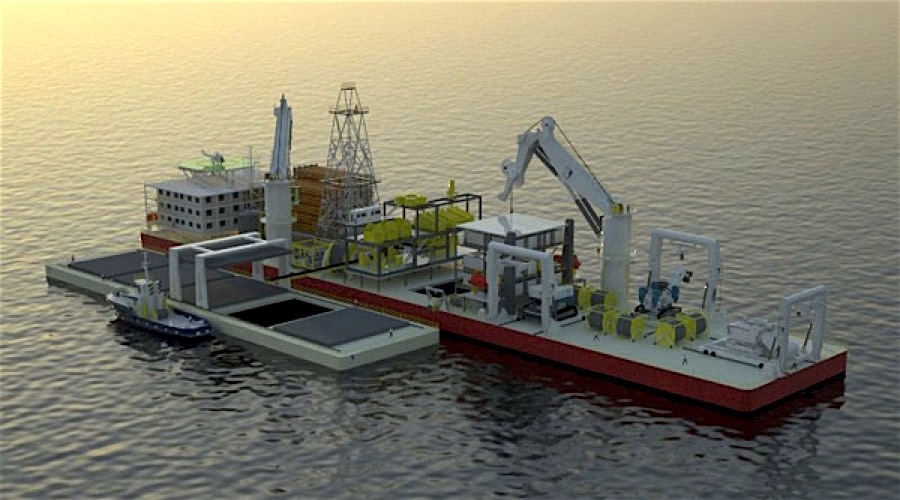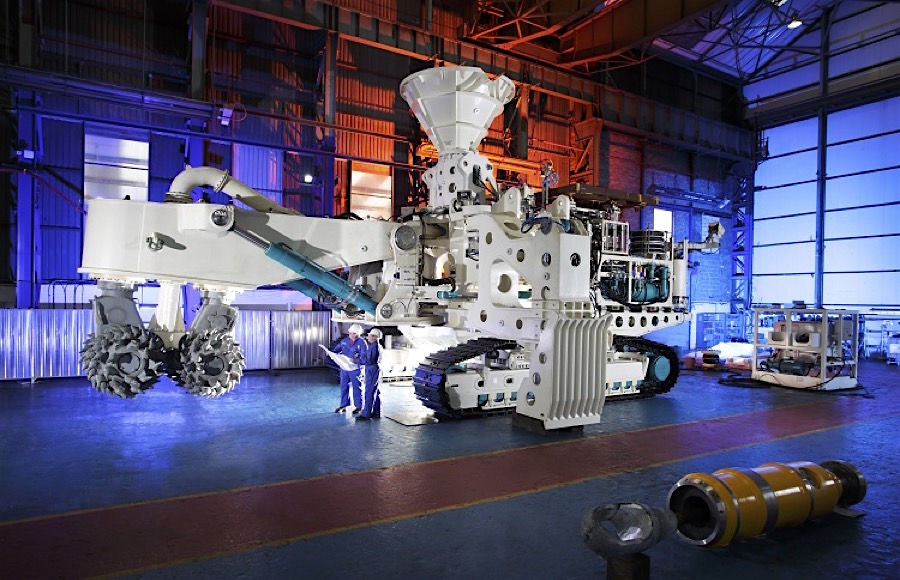
Canada’s Nautilus Minerals (TSX:NUS), one of the world’s first seafloor miners, is on track to start operations at its Solwara 1 gold, copper and silver project off the coast of Papua Guinea in early 2019.
The Toronto-based company, which also is developing another underwater project, off the coast of Mexico, expects to have all its undersea mining tools ready to go by mid-next year, so it can kick-off operations at the Bismarck Sea-based project shortly after, chief executive Mike Johnston told Seeker.com.

The company’s seafloor production machines, each the size of a small house, are equipped with massive rock-crushing teeth. (Courtesy of Nautilus Minerals)
But the road hasn’t been one except of bumps for Nautilus. Since first proposed, its Solwara 1 project has met with some opposition mostly from environmentalists, who fear the aquatic ecosystem could be severely affected by mining the seabed.
The company also faced some hurdles, including a long-dragged dispute with the Papua New Guinea government, which it was able to put aside in 2014. Since then, progress on the project has moved quickly, while competition has begun to flourish.

An auxiliary cutter goes along the sea floor first, removing rough terrain and creating benches for the other machines to work on. It has a boom-mounted cutting head for flexibility. (Courtesy of Nautilus Minerals)
It’s estimated that the United Nations’ International Seabed Authority (ISA), which is in charge of issuing exploration licences to both governments and companies has granted 26 such permits so far.
Countries including New Zealand, Namibia, Fiji, Tonga, Vanuatu and Solomon Islands have also granted permits for seabed mineral exploration. The Cook Islands has even undertaken a minerals exploration tender process, but PNG is the only country in the region to have granted a licence for ocean floor mining.
10 Comments
Stewart Fernandez
FYI – https://www.linkedin.com/pulse/ultrasonic-sonochemistry-stewart-fernandez
non nuclear slurry density gauges and sensors
hoses
bellows
couplings
valves
all at one source
Sean Muller
There has been diamond mining
off the coast of Namibia for many years. So this mine seems like a benchmark but not a first.
Robert_S_Stewart
Royal IHC near Amsterdam has been making alluvial mining equipment for decades for underwater gold mines in Ghana, Columbia and elsewhere. They are called “Dredges”. The Dutch know something about water, having half of their country under sea level. I never built an underground mine anywhere in the world (35 countries) without a Dutch water engineer in charge of keeping the pumps working and the mines dry. The future is in underwater mining.
John Dezelski
No worry about that thing floating away!
Michael White
The 1st big under-ocean-miner was in 2009 at 31deg 18′ N by 23deg 14′ W over 3 miles deep. The trenches were over 500′ wide spaced 10 miles apart over a 100 mile by 100 mile grid. No small feat. United Nations Division for Ocean Affairs has not issued any permits in this area, nor is aware of any under-ocean-mining at this time.
See a new trench to the right of the above listed location cutting a trough from the Mediterranean to Dakar in Senegal Africa, visible on Google Earth. Note this trench is 5 miles wide, who can do that? Must be a ship with a side to side rover moving back and forth under a ship on the ocean floor.
After the Deepwater Horizon Oil Spill The bottom of the Gulf of Mexico was scraped and dug along the bottom of the Continental shelf on North, West and South sides still barely visible on Google Earth. After finishing the Gulf of Mexico the crew moved to Southern Southern California and began moving North in the Pacific two years ago. Their under-ocean miner swipes side to side over 4 to 5 miles wide then moves forward and swipes again. I assume they are scooping up globs of oil along the base of Continental bench at ocean floors. No clue who this is, UN and the oil co’s don’t admit anyone is mining. Must be a Govt involved.
So, this little adventure is late to the ocean-bottom-mining game.
Also, the tracks look to narrow, on the above pic, for ocean bottom goo, just saying.
MINING.com Editors
Interesting. What was the company’s name? What about the project? What kind of venture was it? Did it ever make it into production?
Michael White
I never found out anything about who is ocean-bottom-mining. I annually monitor sea floors for activity via Google Earth. NOTHING. UN is clueless. Can’t find anyone in oil biz who knows. And it is all in open seas so no nation would have given approval.
The 1st listed above is in Canary Basin west of Canary Islands was an actual deepwater trencher. All the rest are some form of “side to side” rover attached to a ship with a 1 mile swath of ocean floor at a time.
Tavaka Zhou
For sure this damages the ecosystem in the sea, it would have been best to process the material at sea as done on diamond mines thus the mined tailings are put back into sea at the same time. What happens to the dug areas in this case? This looks like a very expensive venture by the mere factor of transporting untreated material ashore.
Leonard Bunce
I have been mining diamonds for 14 years with seabed crawlers one of which is responsible for 22 % of Namibia’s yearly diamond output so yup they do work.
L.Kewa
These machines have been designed and are capable of working under high pressure beyond the 1700 metres the actual mining will take place. No matter what happens, knowledge gained from this venture will propel this industry to new nights. This is from hands on experience with this project.